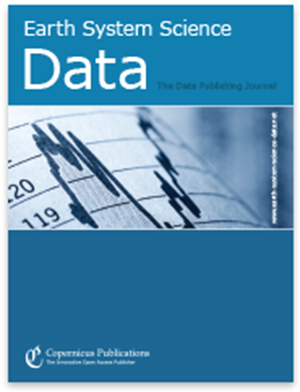Characterizing clouds with the CCClim dataset, a machine learning cloud class climatology
IF 11.6
1区 地球科学
Q1 GEOSCIENCES, MULTIDISCIPLINARY
引用次数: 0
Abstract
Abstract. We present the new Cloud Class Climatology (CCClim) dataset, quantifying the global distribution of established morphological cloud types over 35 years. CCClim combines active and passive sensor data with machine learning (ML) and provides a new opportunity for improving the understanding of clouds and their related processes. CCClim is based on cloud property retrievals from the European Space Agency's (ESA) Cloud_cci dataset, adding relative occurrences of eight major cloud types, designed to be similar to those defined by the World Meteorological Organization (WMO) at 1° resolution. The ML framework used to obtain the cloud types is trained on data from multiple satellites in the afternoon constellation (A-Train). Using multiple spaceborne sensors reduces the impact of single-sensor problems like the difficulty of passive sensors to detect thin cirrus or the small footprint of active sensors. We leverage this to generate sufficient labeled data to train supervised ML models. CCClim's global coverage being almost gapless from 1982 to 2016 allows for performing process-oriented analyses of clouds on a climatological timescale. Similarly, the moderate spatial and temporal resolutions make it a lightweight dataset while enabling straightforward comparison to climate models. CCClim creates multiple opportunities to study clouds, of which we sketch out a few examples. Along with the cloud-type frequencies, CCClim contains the cloud properties used as inputs to the ML framework, such that all cloud types can be associated with relevant physical quantities. CCClim can also be combined with other datasets such as reanalysis data to assess the dynamical regime favoring the occurrence of a specific cloud type in association with its properties. Additionally, we show an example of how to evaluate a global climate model by comparing CCClim with cloud types obtained by applying the same ML method used to create CCClim to output from the icosahedral nonhydrostatic atmosphere model (ICON-A). CCClim can be accessed via the following digital object identifier: https://doi.org/10.5281/zenodo.8369202 (Kaps et al., 2023b).利用机器学习云类气候学 CCClim 数据集描述云的特征
摘要我们介绍了新的云类气候学(CCClim)数据集,该数据集量化了 35 年来既定形态云类型的全球分布情况。CCClim 将主动和被动传感器数据与机器学习 (ML) 相结合,为增进对云及其相关过程的了解提供了一个新机会。CCClim 基于欧洲航天局(ESA)Cloud_cci 数据集的云属性检索,增加了八种主要云类型的相对出现率,与世界气象组织(WMO)定义的 1° 分辨率云类型相似。用于获取云类型的 ML 框架是通过下午星座(A-Train)中多颗卫星的数据进行训练的。使用多个星载传感器可减少单传感器问题的影响,如被动传感器难以探测薄卷云或主动传感器的足迹较小。我们利用这一点来生成足够的标记数据,以训练有监督的 ML 模型。CCClim 的全球覆盖范围从 1982 年到 2016 年几乎没有间隙,因此可以在气候学时间尺度上对云进行过程导向分析。同样,适中的空间和时间分辨率使其成为一个轻量级数据集,同时可以直接与气候模型进行比较。CCClim 为研究云层提供了多种机会,我们仅举几个例子。除了云类型频率,CCClim 还包含作为 ML 框架输入的云属性,因此所有云类型都可以与相关物理量联系起来。CCClim 还可与其他数据集(如再分析数据)相结合,评估有利于特定云类型出现的动力学机制及其属性。此外,我们还举例说明了如何将 CCClim 与二十面体非流体静力学大气模型 (ICON-A) 的输出结果进行比较,从而评估全球气候模型。可通过以下数字对象标识符访问 CCClim:https://doi.org/10.5281/zenodo.8369202(Kaps 等人,2023b)。
本文章由计算机程序翻译,如有差异,请以英文原文为准。
求助全文
约1分钟内获得全文
求助全文
来源期刊

Earth System Science Data
GEOSCIENCES, MULTIDISCIPLINARYMETEOROLOGY-METEOROLOGY & ATMOSPHERIC SCIENCES
CiteScore
18.00
自引率
5.30%
发文量
231
审稿时长
35 weeks
期刊介绍:
Earth System Science Data (ESSD) is an international, interdisciplinary journal that publishes articles on original research data in order to promote the reuse of high-quality data in the field of Earth system sciences. The journal welcomes submissions of original data or data collections that meet the required quality standards and have the potential to contribute to the goals of the journal. It includes sections dedicated to regular-length articles, brief communications (such as updates to existing data sets), commentaries, review articles, and special issues. ESSD is abstracted and indexed in several databases, including Science Citation Index Expanded, Current Contents/PCE, Scopus, ADS, CLOCKSS, CNKI, DOAJ, EBSCO, Gale/Cengage, GoOA (CAS), and Google Scholar, among others.
 求助内容:
求助内容: 应助结果提醒方式:
应助结果提醒方式:


